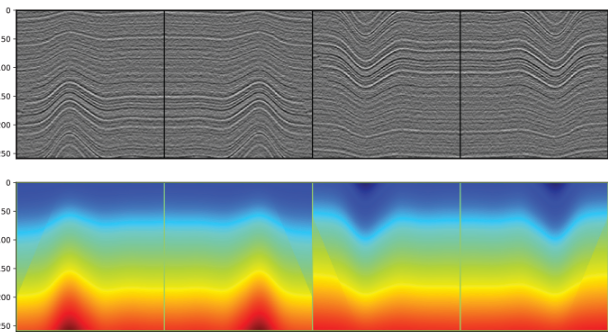Exploring CIGS Deep Learning Seismic: Revolutionizing Seismic Interpretation

CIGS deep learning seismic is transforming the way geophysicists interpret seismic data. This cutting-edge technology leverages the power of deep learning to improve the accuracy and efficiency of seismic analysis. With deep learning models, seismic data, including complex geological features, can be interpreted faster and more accurately than ever before. The result is a more detailed and reliable understanding of subsurface conditions, which is crucial for industries like oil, gas, and mineral exploration.
The application of deep learning in seismic interpretation is gaining significant attention, and CIGS deep learning seismic is at the forefront of this development. This innovative approach allows for better handling of large seismic datasets, overcoming traditional challenges such as noise, data gaps, and inconsistencies. By automating complex tasks such as fault detection, stratigraphy interpretation, and geobody identification, deep learning models provide new insights that were previously difficult to obtain using conventional methods.
Introduction to CIGS Deep Learning Seismic
CIGS deep learning seismic is an innovative technology that uses artificial intelligence (AI) to analyze seismic data. Seismic data helps scientists study the Earth’s layers, and deep learning makes the process faster and more accurate. This technology is important in fields like geology, oil and gas exploration, and environmental studies.
By using deep learning, CIGS can automatically identify patterns in large sets of seismic data. This makes it easier for experts to interpret the data and make decisions based on that information. With the help of deep learning, seismic surveys can be analyzed more efficiently than ever before.
How CIGS Deep Learning Seismic Transforms Data Analysis
The main benefit of using CIGS deep learning seismic is how it improves the accuracy of data analysis. Traditional methods of interpreting seismic data can be slow and often miss important details. However, with deep learning, the model is trained on large amounts of seismic data, which helps it find even the smallest patterns.
Deep learning models used in CIGS are designed to learn from examples. This allows them to improve over time and provide more accurate predictions. For example, the system can recognize certain features in seismic data that indicate the presence of oil or gas reserves deep underground.
Key Benefits of CIGS Deep Learning Seismic:
- Faster analysis of large seismic datasets
- More accurate detection of geological features
- Better decision-making for exploration and environmental studies
- Cost-effective solution for analyzing seismic data
The Future of CIGS Deep Learning Seismic
The future of CIGS deep learning seismic looks very promising. As more data is collected and more models are trained, the accuracy and efficiency of seismic interpretation will continue to improve. This technology could change the way we explore the Earth, making it easier to discover natural resources like oil and gas.
CIGS deep learning seismic will also play a key role in environmental monitoring. By analyzing seismic data, experts can better understand the Earth’s structure and how it changes over time. This can help in monitoring earthquakes, landslides, and other natural disasters.
How CIGS Deep Learning Seismic Will Shape the Future:
- Revolutionize resource exploration industries
- Improve monitoring of natural disasters
- Aid in environmental protection and sustainability efforts
How CIGS Deep Learning Seismic Supports Real-Time Decision Making
One of the exciting features of CIGS deep learning seismic is its ability to assist in real-time decision-making. By analyzing seismic data as it is collected, deep learning models can provide immediate insights into geological conditions, allowing experts to make faster decisions. This is particularly important in industries like oil and gas exploration, where timely decisions can impact production and safety.
Real-time decision-making also has benefits for environmental monitoring and disaster response. For example, CIGS deep learning seismic can help monitor changes in the Earth’s structure during an earthquake or volcanic activity. By providing real-time data, it can help experts respond quickly to natural disasters, potentially saving lives and minimizing damage.
Real-Time Decision-Making with CIGS Deep Learning Seismic:
- Enables faster detection of geological changes or threats
- Supports timely interventions during natural disasters
- Helps in immediate adjustments to exploration plans or safety protocols
The Role of CIGS Deep Learning Seismic in Resource Exploration
Resource exploration, such as for oil, gas, and minerals, relies heavily on seismic data. CIGS deep learning seismic can dramatically improve the efficiency of this process. By analyzing large sets of seismic data, deep learning models can identify potential resource locations more accurately than traditional methods. This reduces the amount of time and money spent on exploration while increasing the chances of discovering valuable resources.
In addition to identifying new resources, CIGS deep learning seismic can also help optimize extraction processes. By understanding the geological structure more clearly, experts can plan more efficient drilling and extraction techniques, which could lead to reduced costs and higher yields.
How CIGS Deep Learning Seismic Benefits Resource Exploration:
- Faster identification of potential resource locations
- More efficient exploration and extraction techniques
- Reduced costs and risks in resource exploration projects
Conclusion
CIGS deep learning seismic is a game-changing technology that improves how we analyze seismic data. By leveraging the power of artificial intelligence, it helps scientists make more accurate predictions and better decisions. Despite the challenges, the future of this technology is bright, and it will continue to have a major impact on many industries, including energy, environmental protection, and more.
By using CIGS deep learning seismic, experts can analyze large amounts of seismic data quickly and accurately, leading to better outcomes in everything from resource exploration to disaster management.
FAQs
Q: What is CIGS deep learning seismic?
A: CIGS deep learning seismic is a technology that uses AI to analyze seismic data more accurately and quickly. It helps identify geological features, like oil or gas reserves, more effectively than traditional methods.
Q: How does deep learning improve seismic analysis?
A: Deep learning improves seismic analysis by automatically detecting patterns in large sets of seismic data, which helps experts interpret the data more accurately and efficiently.
Q: What challenges does CIGS deep learning seismic face?
A: Some challenges include the complexity of seismic data and the need for large amounts of high-quality data for training deep learning models.
Q: Can CIGS deep learning seismic be used for environmental monitoring?
A: Yes, CIGS deep learning seismic can be used to monitor natural disasters like earthquakes and landslides, as well as to understand the Earth’s structure over time.
Q: What industries benefit from CIGS deep learning seismic?
A: Industries like oil and gas exploration, environmental monitoring, and natural disaster management can benefit from CIGS deep learning seismic technology.




